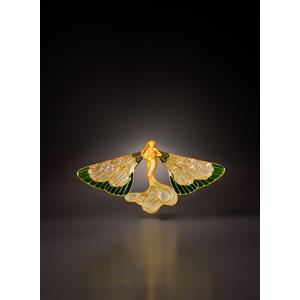DÉTAILS DE L'IMAGE

Epoque Fine Jewels
René Lalique (Ay 1860-1945 Paris)
Art Nouveau nymph pendant/brooch
Designed as a winged nymph, part female, part butterfly, the naked nymph decorated with skin colour enamel, the outstretched wings in pale green ‘plique-à-jour’ enamel, edged with a dark green ‘plique-à-jour’ border, highlighted with antique mine cut and rose cut diamonds, mounted in 18 karat gold. Greenish ‘contre-émail’ on the reverse. The nymph can also be worn as a pendant. With detachable brooch fitting
Paris, circa 1900
8.3 x 4.1 cm
Signed Lalique and Lalique maker's mark
In fitted box marked R. LALIQUE, 40 Cours-La-Reine, Paris
A similar nymph by Lalique is part of the collection of the Lalique Museum in Hakone, Japan
René Lalique (1860-1945) was a renowned French artist, jeweler and glass designer. He was one of the most influential figures in the Art Nouveau and Art Deco movements in the late 19th and early 20th centuries. He began his career as a jewelry designer, creating intricate and nature-inspired pieces that gained him acclaim among the elite of his time. His jewelry was characterized by meticulous attention for detail. He combined traditional jewelry techniques with innovative designs and techniques, creating pieces that were both beautiful and technically impressive.
The entire design of this brooch is steeped in the Art Nouveau aesthetic. The central focus of the brooch is the nymph motif, a characteristic element of Lalique's work. The nymph is often depicted as a sensual, mythical female figure, often with flowing hair and graceful curves, representing the connection between nature and human beauty. Lalique's interpretation of the nymph is known for its exquisite detail and fluid lines. René Lalique was renowned not only for his design sensibilities but also for his exceptional craftsmanship. Each element of this brooch is meticulously crafted, from the precise setting of the diamonds to the delicate application of ‘plique-à-jour’ enamel.
The French term ‘plique-à-jour’ refers to a specific enameling technique that has no backing. In this brooch, the delicate dark and light green transparent enamel is meticulously applied, resembling the iridescent wings of an insect. This technique allows light to pass through the enamel, creating a stunning stained-glass effect reminiscent of a cathedral window.
The brooch, designed to be worn as a pendant as well, boasts a generous width of 8,3 cm, undoubtedly elevating it to the status of a substantial, truly remarkable and adaptable piece of jewelry. The brooch becomes a wearable work of art, where size plays a pivotal role in enhancing the impact of the artistic design. Much like a painter's palette, it beckons the beholder to explore the intricate details, its colors and overall sense of graceful movement, making it a unique and visually striking accessory that captures the essence of the Art Nouveau movement.
René Lalique's jewelry designs remain highly collectible and are considered some of the most influential and beautiful examples of jewelry from the Art Nouveau period. His innovative approach to materials, deep connection to nature, and commitment to artistic craftsmanship continue to inspire jewelry designers. His pieces are renowned for their rarity and desirability among collectors and museums worldwide.



 TÉLÉCHARGER L'IMAGE
TÉLÉCHARGER L'IMAGE